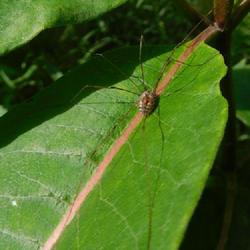Took a wander through the milkweed yesterday afternoon (between the rain showers) to see how the Monarchs are doing ... wow. They were everywhere (along with a few other interesting bugs)! I'll start with the 'others' ... I never realized so many critters like the milkweed.
Basic flys...


Earwig...

Daddy long-legs ... they both 'are' and are 'not' spiders: because there are two types of bugs referred to as 'Daddy Long-legs' and both types fall under the 'class' of Arachnida. (Short biology lesson: Kingdom, phylum, class, order, family, genus, species. 'Arachnida' contains everything from scorpions to ticks to spiders.) But the two types of daddy long-legs fall into different orders - and the one most commonly referred to as 'daddy long-legs' (sometimes referred to as 'harvestman') fall into the order 'Opiliones' - (whereas the other type, aka 'cellar spiders') from the order 'Pholcidae' are true spiders ... you can tell the difference by the fact that true spiders have jointed bodies, whereas 'harvestman' have a body all of one piece. End of biology lesson (apologies to those not interested).
So, in the milkweed... harvestman, which range from pale brown or gold body colours to deep or dark brown. In my area, I've heard these referred to as 'ladder-backs' because of their two-toned patterns

The bright red spot on the back of this next one is not a marking - it's actually a parasitic mite.
And now, the Monarch caterpillars... there were so many, I will not attempt to post them all, just a sampling of some of them...
Notice the tiny egg to the right of the 'pillar'





I've pretty much 'always' known they eat the leaves... did not realize they also eat the seed pods... I found a number of them chowing down on the pods.



So, once the 'pillars reach an age of about 18 days, they get ready for the next stage. They often leave the milkweed patch (to avoid predators), in preparation of forming their chrysalis ... find a location to attach, and hang upside down / forming a 'J' shape ... and, within 24 hours, form their chrysalis.


In my yard, they often attach to the wire fences...

They remain in the chrysalis stage for 1-2 weeks and, about 24 hours before coming out, the outer shell will become transparent (you will be able to see their wings thru the wall)...


If I can catch one at that point, I will post.
 https://monarchwatch.org/wayst...
https://monarchwatch.org/wayst...















